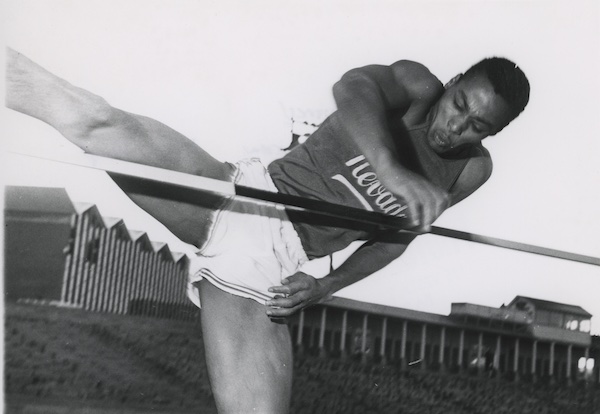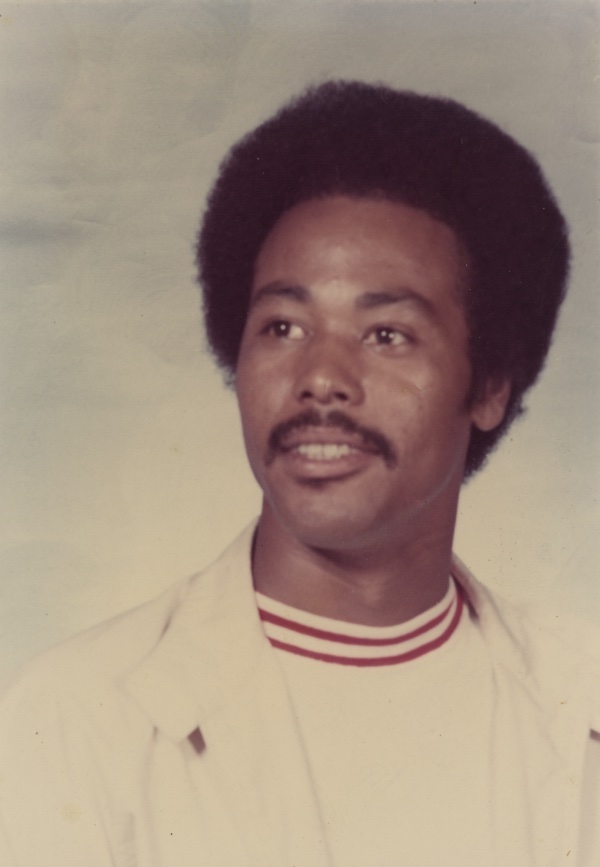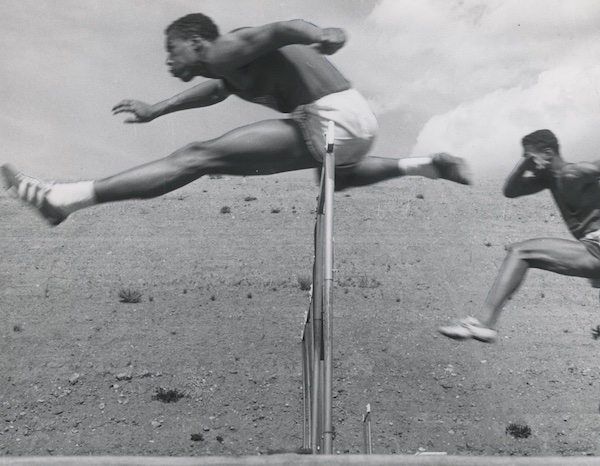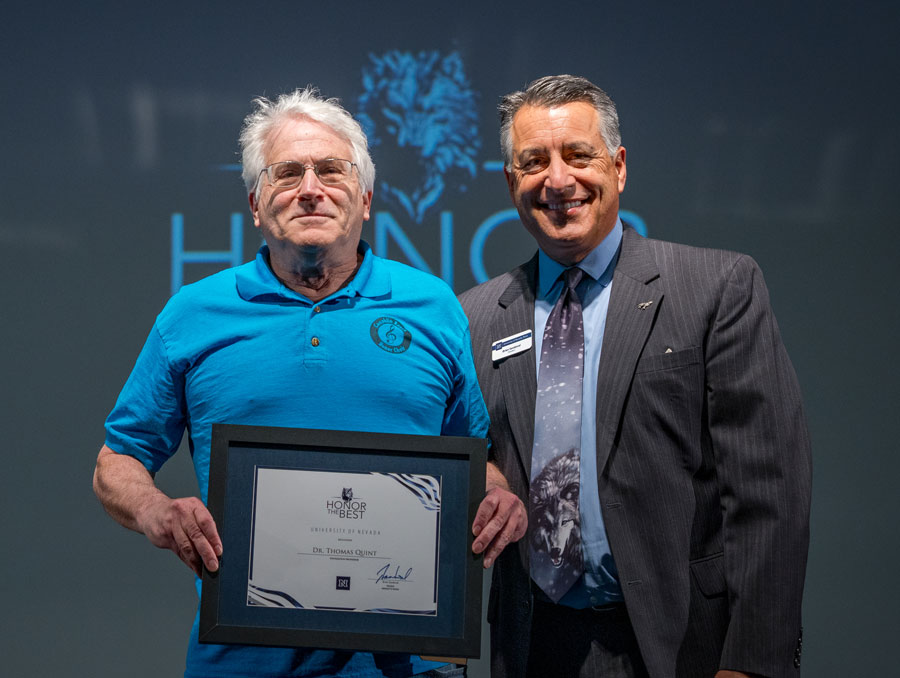Otis Burrell’s career as one of the country’s top high jumpers throughout the 1960s remains worth noting and celebrating.
Burrell did things in the most understated and admirable way possible. As he was racking up national titles for the Wolf Pack track team – he became NCAA champion with his win in 1966 – Burrell made sure people understood that he wasn’t one to brag or overstate what he had accomplished.
Reporting of the time described Burrell as “quiet” and “soft-spoken” and “thoughtful.”
Few high jumpers in America can lay claim to the superlatives and the durability Burrell demonstrated throughout the 1960s, one of the great golden ages of American track and field.
From 1963-70 in the annual rankings compiled by Track & Field News (long called “The Bible of the Sport”) Burrell was ranked as the country’s No. 1 high jumper in 1965, 1966 and 1969. He was ranked second in 1967, and for eight consecutive years was ranked in the country’s top 10. Fifty-four years after his final appearance in the T&FN rankings in 1970, Burrell still is the ninth all-time U.S. high jump scorer in the prestigious rankings.

Burrell, who won a silver medal in the Pan American Games high jump in 1967, established a school record of 7 feet, 2 ½ inches in 1966 on Jan. 29, 1966. It was a standard that stood for two decades until 1986, when the Wolf Pack’s Mark Trujillo broke it with a 7-3 ½ leap.
Burrell was inducted into the Wolf Pack Hall of Fame in 1978. He was named the Reno Gazette-Journal’s No. 22 All-Time Greatest Athlete of the 20th Century for Northern Nevada. He was the ninth person to ever clear 7 feet in the high jump.
And to think that it all started with a random phone call to the University one day. If that phone call hadn’t been answered, Otis Burrell no doubt would have still been a great high jumper. But for the University of Nevada, Reno, it was a phone call that helped put the University on the map.
As the globe-trotting Burrell soared, so too, did the University.
‘How soon can you get here?’
RICHARD “DICK” DANKWORTH WAS one of the most popular and successful faculty members the University of Nevada had ever seen. Dankworth, a former Marine who was always an upbeat, smiling presence, was a southern Californian who was a Little American football player at Pepperdine University. Dankworth took over the Wolf Pack track and field team in 1960.
Under Dankworth’s direction, the Pack would win eight Far Western Conference track championships. Dankworth would later become the University’s director of Summer Session and would serve as a vice president under President Joe Crowley.
During his induction into the Wolf Pack Hall of Fame in 1986, Dankworth shared the story of a phone call he received one day. Dankworth had been poring over his team’s record books, which by 1964 were looking fairly impressive. He would produce 71 individual conference champions, 18 All-Americans and six internationally ranked athletes.
Of all the Pack’s records, one looked like it needed some work: the high jump.
Then the phone rang. It was a young man from Los Angeles Valley College named Otis Burrell.
“Mr. Dankworth, I’d like to go to Nevada U., and be on your track team,” Burrell said. “I’m a high jumper.”
Still closely connected to southern California’s track and field scene, Dankworth later said, “I had known Burrell’s ability in high school in Los Angeles, and assumed he’d be snapped up by one of the bigger universities, such as USC.”
“What’s your best height?” Dankworth asked the voice on the phone.
Burrell said he could do about 7 feet, which he had cleared in 1963. “By the way,” he asked, “what’s your school record?”
“It’s … how soon can you get here?” Dankworth, excited and a bit incredulous about his luck, replied. (1)
Burrell later said the choice of phone calls boiled down to Nevada and Grambling. He called Grambling first, but the head track and field coach wasn’t available to answer his call. (2)
Dankworth always remembered how fortunate he was to have answered.
“You know, he called me and I happened to be in my office,” Dankworth said. (3)
For the remainder of his life, Dankworth was convinced that Burrell was one of the greatest athletes and people he had ever been around.

In addition to his championships, Burrell, even at a young age, possessed a teacher’s patient temperament. He loved interacting with young people, as Lyle Freeman, a 14-year-old in 1966, found out one day at a Wolf Pack track practice at Mackay Stadium. Freeman, a student at Darrell Swope Junior High School, was also a high jumper. He approached Burrell hesitantly, not quite sure if Burrell would give him the time of day.
Of course, Burrell did. He gave Freeman a friendly nod and proceeded to give all the high jumping advice a 14-year-old could ever ingest in one session.
“Burrell was a phenomenon then,” Freeman recalled later. “But he took the time and effort to teach me to jump.” (4)
That sort of interaction never surprised Dankworth.
“I think Burrell would have to be the ‘athlete of the decade,’” Dankworth said in 1970.
Well aware of other great Wolf Pack athletes such as future NFL Hall of Famer Marion Motley, who played football in the early 1940s for the University and would go on to help break professional football’s color barrier in 1946, Dankworth added, “(Burrell) could possibly be the greatest athlete Nevada ever had, performance-wise.” (5)
‘I’d rate myself No. 1 on the basis of what I have done in international competition’
OTIS BURRELL QUICKLY ESTABLISHED HIMSELF as a force as a collegiate high jumper, as well as on the international stage.
During his time at Nevada, he won U.S. Track and Field Federation and AAU crowns. He toured and competed in Europe throughout 1965 and won national titles in the AAU and NCAA indoor meets in 1966. His NCAA crown in 1966 was historic. It would not be equaled until the Pack’s Kamy Keshmiri –son of one of Burrell’s teammates, Joe Keshmiri – won the NCAA discus crown in 1990.
It was a heady time for Burrell, who was one of a handful of high jumpers in the world who had cleared the formidable 7-foot barrier in the high jump. He set the Wolf Pack school record of 7-2 ½ in Portland, Oregon on Jan. 29, 1966, and then went a step further, having the bar set at Valeriy Brumel of Russia’s world record of 7-5. Burrell took three attempts at Brumel’s mark. He came agonizingly close to clearing it. On his third attempt, Burrell’s trail leg nudged the bar off. (6)
Burrell was in rarified air, an elite competitor who was known for rarely losing when it mattered most.
Wolf Pack basketball Hall of Famer Napoleon “Nap” Montgomery, upon the death of his teammate Larry Moore in 1999, remembered what kind of special talent Burrell possessed.
Moore was also a Wolf Pack high jumper, and at a meet in 1965, Moore jumped 6-8 to break the Mackay Stadium record of 6-5 ½ which notably had been held since by 1955 legendary singer Johnny Mathis while competing for San Francisco State.
“Larry held (the Mackay Stadium record) for about five minutes,” Montgomery said. “He jumped 6-8 but was overshadowed because Otis Burrell went 7-1 later that day.” (7)
Burrell, for his part, let his performances speak for themselves. When pressed, Burrell wouldn’t shy away from what his performances said about his ability.
“I’d rate myself No. 1 on the basis of what I have done in international competition,” he said in 1970. (8)
“He was a great competitor,” Dankworth added. “He was one of the very best. Otis was always tough in national and international competition.” (9)

Burrell was 24 years old in 1968 and in his athletic prime as the world turned its attention to the Summer Olympics in Mexico City that year. 1967’s Track & Field News rankings had him at No. 4 in the world. The Olympic Track and Field Trials were held amid the pine trees of Echo Summit near the south shore of Lake Tahoe that year. Echo Summit and its 7,377-foot altitude was chosen in the hopes that it would mimic the 7,350-foot altitude of Mexico City.
What is considered by many to still be the greatest U.S. Olympic Track and Field team ever assembled was chosen at that year’s U.S. Trials.
The team included world record holders Jim Hines in the 100 meters, Tommie Smith in the 200 meters (as well as the great John Carlos), Lee Evans in the 400 meters and Bob Beaman in the long jump. Oregon State’s Dick Fosbury also competed. Fosbury had created a somewhat unorthodox method of “flopping” head-first and backward over the high jump bar. Burrell and Brumel and many of the world’s other top jumpers utilized the more traditional sideways “roll” over the bar. Fosbury and his “Fosbury Flop” would go on to earn a gold medal in Mexico City.
Burrell said later he never seriously considered converting from his preferred style to the “Fosbury Flop” in 1968.
“When I first saw Fosbury “in 1967, I was doing 7-2. He was doing 6-7.” (10)
Burrell, who had also competed in the 1964 Trials but had been slowed by injury, did not make the U.S. Olympic Team in 1968.
Just before he was to compete, Burrell drank some contaminated water, which made him sick. He was given penicillin to treat his illness, which caused an allergic reaction and weakened him further.
A few years later, Burrell was asked about the disappointment of not making the 1968 Olympic Team.
Did it bother him?
“Some,” he said, adding in another interview that it just wasn’t his style to either brag or wallow too much based on his athletic achievements: “I’ve always been introverted. Maybe they thought I was conceited. I used to be embarrassed to talk. … I was quiet back then. I never bragged on myself.” (11) and (12)
‘I love the area …. But I haven’t been able to make a decent living’
Otis Burrell graduated from the University with a degree in education. He was hired to teach at Fred Traner Junior High School in Reno in 1970.
It was a busy time for Burrell. The challenges he faced spoke to what track and field stars in the early 1970s often had to deal with in order to make ends meet. Still classified as “amateurs,” track and field athletes who wished to continue to compete after completing college often needed to work fulltime. Burrell’s days went well beyond fulltime. He taught, coached seventh grade boys basketball and three nights a week was a teacher for the Northern Nevada Construction Opportunities Program, a pre-apprentice program for minorities.
Burrell took his nighttime teaching duties as seriously as his daytime teaching, constantly scrounging to find better learning materials for the young men in his classes, which focused on math, spelling, reading comprehension, grammar and usage, and general science. The work could be taxing and frustrating. But Burrell was proud of the high standard he maintained. He tested frequently. He asked a lot of his students. He wanted them all to succeed. It was, he said, an example of a larger lesson all could benefit from.
“They learned the value of school,” he said. (13)
Education and the advancement of human rights had always been important to Burrell. He had been a chairman for the University’s Black Student Organization, and in 1967 had made his support known as a young Black college professor at San Jose State University, Harry Edwards, began to organize workshops for Black athletes to consider the possibility of boycotting the 1968 Summer Games in Mexico City.
The possible protest was based on America’s long history of segregation and discrimination. In fact, at one of the first such workshops held in the country over 1967’s Thanksgiving weekend at the Second Baptist Church in Los Angeles, Burrell, Lee Evans, Tommie Smith, and UCLA basketball star Lew Alcindor (Kareem Abdul-Jabbar), among others, were in attendance to hear Edwards’ thoughts.
Edwards told Sports Illustrated magazine that the workshops and the possible boycott of Black athletes were a reaction to the fact that “race relations are worse now than ever. … We’re not trying to lose the Olympics for the Americans. …. But it’s time for the Black people to stand up as men and women … You see, this may be our last opportunity to settle this mess of violence.” (14)
Black athletes such as Evans and Smith went ahead and competed in the 1968 Olympics, but made their feelings well known. Smith and Carlos, after finishing first and third in the men’s 200-meter Olympic final, made history during the medals ceremony by lowering their heads and raising their hands in defiance as the “Star-Spangled Banner” played. Today their historic moment is memorialized by a statue on the San Jose State campus, where both were student-athletes.
On April 8, 1970, Black students on the University campus held a three-hour long meeting asking for social, academic and financial change. Rumors were running rampant as well that the University’s first Black professor, Art Professor Ben Hazard, who had joined the faculty only a year before, was not going to be reappointed. The concerns of the Black students were valid. There were only 72 Black students on campus in 1970.
During the meeting, Burrell shared his own experience. He had wanted to pursue a graduate degree following graduation. But Burrell was “met with barriers” as he tried to gain acceptance into the graduate program. Additionally, Burrell noted, it was hard “in getting a job” at the University. (15)
There was a lot at play that day during the meeting. University President N. Edd Miller assured the students that Hazard would be reappointed; later that summer, Hazard would leave the University to become curator at the Oakland Museum. Miller’s assurances that the University could do better did lead to some improvements. By November 1971 the University’s campus minority staff had grown to 22 individuals from minority groups holding faculty-level positions. (16).
Burrell’s participation in the April meeting hadn’t gone unnoted, and his presence and his words had seemed to help. Having one of the world’s most well-known athletes provide their own personal testimony had proven powerful.
Burrell would serve for a time as the director of the University’s Equal Opportunity Program, though it still remained a challenge for Burell to find the time to train, travel and compete at world-class level.
Then an opportunity arose. It was colorful and captured the attention. It promised money. The International Track Association, which was formed in fall 1972, attempted to bring professional track and field to America. World-class athletes such as Burrell, John Carlos, Lee Evans, world record holding miler Jim Ryun, pole vaulter Bob Seagren and on the women’s side Olympic gold medalist Wyomia Tyus and others gave the fledgling league some legitimacy. Meets were televised and the athletes were paid, which meant that they lost their amateur standing and could not compete in future Olympic Games. The ITA was high on entertainment value – shot putter Brian Oldfield, for example, often competed in a speedo and would lumber powerfully alongside top sprinters in match races over 40 yards. The association also, thanks to the great talent of athletes, many of whom were members of that incredible Olympic team from ’68, was highly competitive. The ITA’s 51 meets from 1973-76 saw 34 world bests. (17)
For athletes like Otis Burrell, “professional” status didn’t necessarily translate into huge paydays. Burrell said in 1974 that in 10 ITA meets he had earned a grand total of $2,000, while also having to work two jobs in Los Angeles. John Carlos, still one of the fastest men in the world at age 29, had earned about $6,100.
Burrell, who was working with Carlos to form an Inglewood, California-based track club, said at the time that he missed living in Northern Nevada: “I love the area …. But I haven’t been able to make a decent living here … I was teaching at a junior high school last year and worked as an assistant track coach at Los Angeles Southwestern Junior College. We finished second in the state. I’m more of an administrator than a coach, though.” (18)
‘I tell them to let them know I’ve been around’
In the late 1970s and beyond, several top Black track and field athletes from America were asked to coach and advise athletes from the developing nations of the world. The move helped galvanize the incredible diversity elite track and field sees today. Burrell spent much of the late 1970s serving as a national coach in Nigeria and would also have stints as a national coach in the ‘90s in Saudi Arabia and Pakistan.
Burrell returned to serve as an assistant coach – as well as serve as the recreation director at the Sierra Nevada Job Corps in Stead – at Nevada from 1986-1989 under Coach Jack Cook.
Cook, like Dankworth a Wolf Pack Hall of Fame track and field coach who led the Pack for two decades, realized the treasure trove of knowledge and experience the Wolf Pack had in Burrell.
“When I recruit a high jumper, I tell them I have the best jump coach in the nation,” Cook said.
The legendary Reno Gazette-Journal sportswriter Steve Sneddon described Burrell in 1989. At 45, Burrell still very much looked like the 6-foot-2, 170-pound champion he was back in 1966: “Watch Otis Burrell from afar and put the memory in cruise control on a windy afternoon at Mackay Stadium. The year could be 1966. There’s the solitary slender figure standing near the high jump pit. He’s wearing the blue and silver Nevada Wolf Pack jacket, a dark blue stocking cap and gray muffler to battle the merciless winds coming of Peavine Mountain.”
Burrell, for his part, said it was still difficult for him to talk about all of his accomplishments. Though Burrell added that when the moment was right and a story might have application in building an athlete’s confidence or in reassuring them, he might share something from his athletic past.
“I’ve been in Sports Illustrated,” said the athlete who had traveled to more than 50 countries during his career. “I’ve been to Russia. Not too many people here have been in Russia. I’ve been to Burma. Hardly anyone’s been to Burma. I’ve been to Vietnam and I wasn’t even in the army. … I tell them to let them know I’ve been around.” (19)
Cook said his respect for Burrell was total. Here was an athlete who had done so much, and had also had to face disappointment, the ’68 Olympic Trials chief among them.
Yet here Burrell was, coaching, listening, observing, sharing the occasional story with just the right meaning at just the right time.
“He’s a competitor,” Cook said. “He’s been able to fight through adversities all his life.” (20)
Over the past several years, Burrell has continued to teach and coach. After his stints in the 1990s coaching overseas, Burrell was an assistant cross country/track and field coach at Washington Preparatory School in Los Angeles, a program with no all-weather track, which required the former No. 1-ranked U.S. high jumper to drag and mark the lanes of the track before every meet. Burrell was an adjunct professor at Santa Monica College from 2008-2012, coaching jumps, hurdles and sprints, as well as teaching kinesiology and physical education. (21)
Since 2011, Burrell has coached hurdles and the high jump at Palos Verdes Peninsula High School. The focus remains the same. His ability to impact others remains his greatest gift. The 30 to 35 boys and girls Burrell coaches have a saying about his coaching: “Hurdles4lyfe.”
Otis Burrell will turn 80 years old on May 9. It doesn’t sound like he is slowing down anytime soon. His role, he has written, continues to be to help his young athletes “come to the realization that they can identify and apply their natural talents.” (22)
As far as talents go, there are few like Otis Burrell in the University’s history.
It all started with a random phone call to the Wolf Pack track office nearly 60 years ago.
And what a journey it has been.
NOTES
- “It’s … how soon can you get here?” Dankworth, excited and a bit incredulous about his luck, replied: “High jumper fell into UNR’s lap,” Reno Gazette-Journal, June 22, 1988.
- He called Grambling first but the head track and field coach wasn’t available: “Burrell: UNR’s globe-jumping Hall of Famer,” Reno Evening Gazette, Dec. 19, 1979.
- “You know, he called me and I happened to be in my office,” Dankworth said: “Wolf Pack Trackmen Gain National Stature,” Nevada State Journal, Oct. 12, 1974.
- “Burrell was a phenomenon then,” Freeman recalled nearly 30 years later. “But he took the time and effort to teach me to jump”: “Athletes, coaches criticize decision,’ Reno Gazette-Journal, May 4, 1994.
- “(Burrell) could possibly be the greatest athlete Nevada ever had, performance-wise”: “Jumping Becomes Hobby With Ex-Pack Star,” Nevada State Journal, Feb. 22, 1970.
- He came agonizingly close to clearing it. On his third attempt, his trail leg nudged the bar off: “Wolf Pack’s Burrell still has goals to leap for,” Reno Gazette-Journal, May 1, 1989.
- “Larry held (the Mackay Stadium record) for about five minutes,” Montgomery said. “He jumped 6-8 but was overshadowed because Otis Burrell went 7-1 later that day”: “Former Pack basketball great dies at 54,” Reno Gazette-Journal, June 30, 1999.
- “I’d rate myself No. 1 on the basis of what I have done in international competition,” he said in 1970”: “Jumping Becomes Hobby With Ex-Pack Star,” Nevada State Journal, Feb. 22, 1970.
- “He was a great competitor,” Dankworth added. “He was one of the very best. Otis was always tough in national and international competition”: “Wolf Pack Trackmen Gain National Stature,” Nevada State Journal, Oct. 12, 1974.
- “When I first saw Fosbury “in 1967, I was doing 7-2. He was doing 6-7”: “Wolf Pack’s Burrell still has goals to leap for,” Reno Gazette-Journal, May 1, 1989.
- “Some,” he said, adding in another interview that it just wasn’t his style to either brag or wallow too much based on his athletic achievements: “Jumping Becomes Hobby With Ex-Pack Star,” Nevada State Journal, Feb. 22, 1970.
- “I’ve always been introverted. Maybe they thought I was conceited. I used to be embarrassed to talk. … I was quiet back then. I never bragged on myself”: “Wolf Pack’s Burrell still has goals to leap for,” Reno Gazette-Journal, May 1, 1989.
- “They learned the value of school”: “Construction jobs program helps Reno’s minorities,” Nevada State Journal, May 16, 1970.
- “You see, this may be our last opportunity to settle this mess of violence”: “A Step to an Olympic Boycott,” Sports Illustrated Magazine, Dec. 4, 1967.
- Additionally, he noted, it was hard “in getting a job” at the University: “Black students list grievances at U. of N.,” Nevada State Journal, April 8, 1970.
- By November 1971 the University’s campus minority staff had grown to 22 individuals from minority groups holding faculty-level positions: “Reno campus minority staff – 22 faculty, 61 others,” Reno Evening Gazette, Nov. 5, 1971.
- Its 51 meets from 1973-76 saw 34 world bests: International Track Association, Wikipedia entry.
- “I’m more of an administrator than a coach, though”: “John Carlos: ‘As bad in Track as Ali in Boxing,” Nevada State Journal, Aug. 2, 1974.
- “I tell them to let them know I’ve been around”: “Wolf Pack’s Burrell still has goals to leap for,” Reno Gazette-Journal, May 1, 1989.
- “He’s been able to fight through adversities all his life”: “Wolf Pack’s Burrell still has goals to leap for,” Reno Gazette-Journal, May 1, 1989.
- Burrell was an adjunct professor at Santa Monica College from 2008-2012, coaching jumps, hurdles and sprints, as well as teaching kinesiology and physical education: Otis Burrell LinkedIn.
- “ … come to the realization that they can identify and apply their natural talents”: Otis Burrell LinkedIn.














